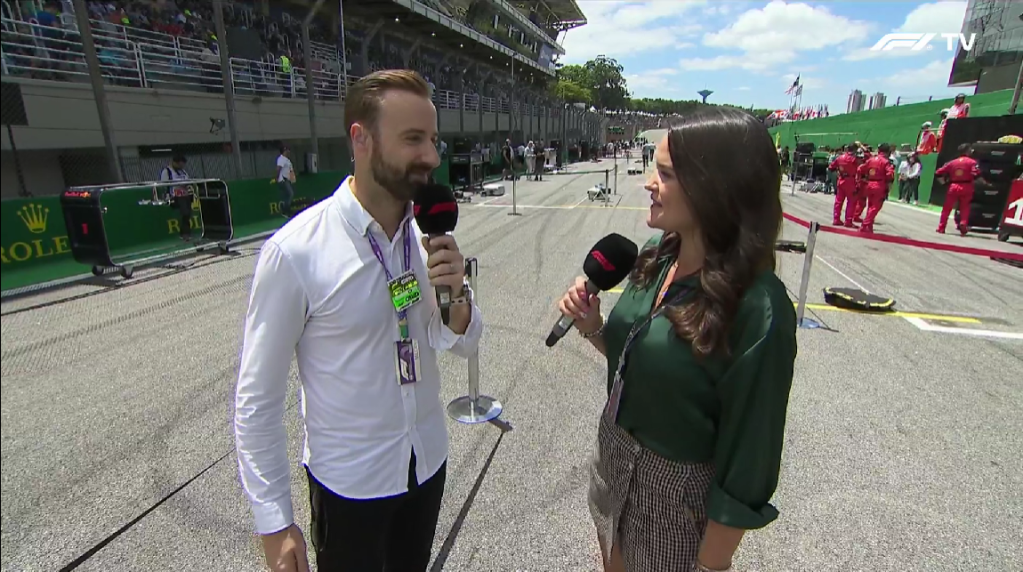In recent years, Formula 1 has evolved its direct-to-consumer product, F1 TV. The platform has grown since launch in 2018, with the championship now providing fans with a rich in-house offering during a race weekend.
As well as their non-live YouTube offering, the series also presents live pre- and post-race content on YouTube and through their DTC platform, meaning the F1 now stands directly alongside the broadcasters that air the sport.
F1 TV caters to international fans, similar to how Sky Sports serves fans in the UK. But how to the services compare from a pre-race build-up perspective?
Motorsport Broadcasting has analysed F1 TV’s and Sky’s build-up to last weekend’s Sao Paulo Grand Prix to see where the similarities and differences lie in their offering. With both Drivers’ and Constructors’ Championships well wrapped up, it is challenging for F1 and its stakeholders to create engaging content as the 2023 season concludes.
How did F1’s in-house team fare with 60 minutes to play with, and how did Sky fill 70 minutes of content (excluding commercials)? And are UK fans missing out by being unable to access F1 TV’s premium live content?
Where F1 TV takes the lead
Laura Winter and James Hinchcliffe led F1 TV’s output that included former Lotus and Renault race engineer Julien Simon-Chautemps on-site. Technical expert Sam Collins and commentators Alex Jacques and Jolyon Palmer provided additional build-up analysis from F1’s UK base.
The pre-race broadcast focused on the thing that mattered the most: the racing, dissecting the fortunes of all 10 teams and 20 drivers, each part given time to breathe, without the need to rush into an ad-break or onto the next segment.
F1 TV’s ‘all drivers covered’ mantra was evident during their grid walk, where Hinchcliffe walked from the rear to the front of the field. The format reminded me of NBC’s IndyCar build-up (a team that Hinchcliffe is also part of), serving to bring fans up to speed with the storylines in a digestible manner.
Whether it was Red Bull or Alfa Romeo, F1 TV had it covered. ‘Hinch’ was brilliant throughout the build-up. Like Sky’s Karun Chandhok, Hinchcliffe is a walking F1 encyclopaedia!
By way of comparison, Sky’s broadcast predominantly focused on the top contenders (similar to their 2022 output) in a circular and sometimes disjointed fashion, with the tailenders receiving minimal coverage from the pay TV broadcaster.
F1 TV’s broadcast felt accessible to fans of all generations, introducing everyone to the race as if it was their first time watching during the weekend, irrespective of their viewing habits. The broadcast never ‘assumed knowledge’, which I really liked. Features aired to recap both Friday’s qualifying and Saturday’s Sprint race, reminiscent of the BBC’s and ITV’s old F1 broadcasts.

As expected, the show utilised F1’s Biggin Hill archive and the terabytes of data that they receive during a race weekend. However, while both features in question were good, I was left wanting more in both areas.
Will Buxton narrated a piece looking back at Brazil 2003, showcasing F1’s history, but never gave fans a new take on events. It felt like a piece I could watch on YouTube with no ‘added value’ like previous segments on Sky have had.
Later in the broadcast, Collins compared the tyre degradation of Mercedes’ George Russell and Red Bull’s Max Verstappen, showing where Russell lost out to Verstappen over the course of the Sprint. This was a superb piece of analysis and really showed where Verstappen is a class ahead of his rivals.
An issue I had with both Sky’s and F1 TV’s broadcasts though, is that neither broadcaster explained the tyre degradation situation is simple terms.
There was lots of chat, and helpful analysis from Collins on F1 TV, but neither aired a graphic comparing the amount of tyre compounds (Soft, Medium and Hard) each driver had left, which felt like a major oversight considering how much chatter there was on the subject.
Nevertheless, there is only so much data-driven and technical content you can create for the build-up without overwhelming (or alienating) the audience.
Each weekend, F1 creates Tech Talk, a segment fronted by Collins for their social channels, highlighting the technical updates across the whole of the grid.
While Sky adopts a personality-led approach to attract the Drive to Survive convert, F1 is streets ahead of the competition when it comes to data and technical content creation.
…and where Sky hit the DRS
If you want a show that brings you closer to the personalities involved with F1 as well as the wider storylines beyond the race, Sky Sports is the place for you.
Fronted by Simon Lazenby, Naomi Schiff and Karun Chandhok, Sky’s build-up as always aired interviews with the key drivers in their 90-minute broadcast before lights out. David Croft gave a brief summary from the commentary box, with Rachel Brookes and Ted Kravitz down in pit lane and the paddock.
There were two standout features in Sky’s expansive pre-show: a behind the scenes look at Ferrari, and Martin Brundle’s grid walk.
Filmed during the Mexican Grand Prix weekend, a camera crew followed the Ferrari team around, giving fans a new perspective on the Scuderia. In the week following the race, Sky’s production team turned around a 15-minute edit, which aired in two segments during the Brazil weekend.
Arguably, it is one of the best behind the scenes pieces you will see any F1 TV broadcaster air this season, even more impressive considering the turnaround to get the piece on-air.
In comparison, Netflix’s Drive to Survive airs months after footage is shot. That is not to do Drive to Survive a disservice, merely to highlight the effort involved from Sky on this front.
As amazing as features like these are, the logistics of organising the pieces mean that they are few and far between. Sky’s other build-up features on George Russell’s firsts and Daniel Ricciardo were likely much quicker to turn around that the Ferrari segment.
Brundle’s grid walk was its usual chaotic self, with a mix of driver and celebrity interviews, and clearly different to the style offered up by F1 TV. ‘Inform, educate and entertain’ may be the BBC’s mission, but it is also a statement that is pertinent across the whole of the broadcasting landscape.
Sky’s iteration of the grid walk (and its predecessors) serves to inform and educate, by bringing fans the latest news from the grid, intertwined with interviews from stars past and present.
In Brazil, this included a brief catch up with Safety Car driver Bernd Maylander, ex-Brazilian star Rubens Barrichello (informing), and explaining what has changed on the Ferrari since Friday qualifying (educating).
But there is the third branch: entertaining, and Brundle’s grid walk fulfils that mantra. Whether it is hearing him say “Balloons out and away we go!” or him trying to get some sense out of Machine Gun Kelly, it is entertaining television. Sometimes the grid walks miss wildly, but that is live television for you.
While the F1 TV version of the grid walk was informative and entertaining, the format was dry and unsuitable for a broadcaster like Sky who are trying to attract new fans to F1.
Brundle’s grid walk lasted almost twice the length of Hinchcliffe’s, but had a ‘Fast and Furious’ style to it, rather than wandering from back to front. Both grid walks were good, but the target audience for both parties is different and that is the key here.
Elsewhere, Sky’s broadcast featured 3D analysis on the Sky Pad, overlaying Verstappen’s and Leclerc’s qualifying laps, the graphic and Chandhok’s usually excellent description giving fans an idea of where the differences were between the two drivers during Q3.
Chandhok’s knowledge came into play throughout the build-up, linking Lance Stroll’s qualifying performance to engineer Tom McCullough, who was also Nico Hulkenberg’s engineer when he took pole at Brazil in 2010.
Looking ahead to 2024
Whether you like F1 TV’s or Sky’s build-up more really depends on what you want out of your pre-race content.
If you are an F1 fanatic who does not care so much about the glitz and glamour that surrounds the sport, F1 TV is likely the place for you, the in-house broadcaster continuing to enhance its product.
| F1 TV | Sky Sports F1 |
| + Archive | + Behind the scenes |
| + All rounded | + Grid walk |
| + Data usage | + Leading contenders |
| + Line-up | + Sky Pad |
On the other hand, if you are newer to F1, or like to see the personalities that F1 has on offer, then Sky has this in abundance. The recent changes to their broadcast team, with the additions of Bernie Collins and Naomi Schiff, in place of Johnny Herbert and Paul di Resta, have helped their broadcast.
Having a former Strategy Engineer as part of Sky’s team has benefited them this season, however Collins’ absence has been felt during some race weekends, when she either has not been there or she has been with…. F1 TV.
Arguably, having two separate English speaking presentation teams presenting live F1 dilutes the talent pool, at a time when broadcasters are trying to save costs. Sky likes to put their own mark on their premium events, which makes the idea of them sharing a broadcast with F1 TV unpalatable.
However, the next six months may be tough for F1 at the pay TV broadcaster as inflation bites across the broadcasting world.
F1 has yet to face the brunt of Sky’s cost cuts in the same vein as Sky’s Premier League offering, which saw veteran faces Geoff Shreeves, Martin Tyler and Jeff Stelling leave at the end of the 2022-23 season.
Sources have indicated to Motorsport Broadcasting in recent months that Sky’s F1 budget will be cut for the 2024 season. As F1 TV continues to grow their offering, Sky F1 may well be changing theirs, which will change the dynamic again heading into 2024.
UK fans can access F1 TV’s Sao Paulo Grand Prix build-up via F1 TV Access here.
If you enjoyed this article, consider contributing to the running costs of Motorsport Broadcasting by donating via PayPal. If you wish to reproduce the contents of this article in any form, please contact Motorsport Broadcasting in the first instance.

